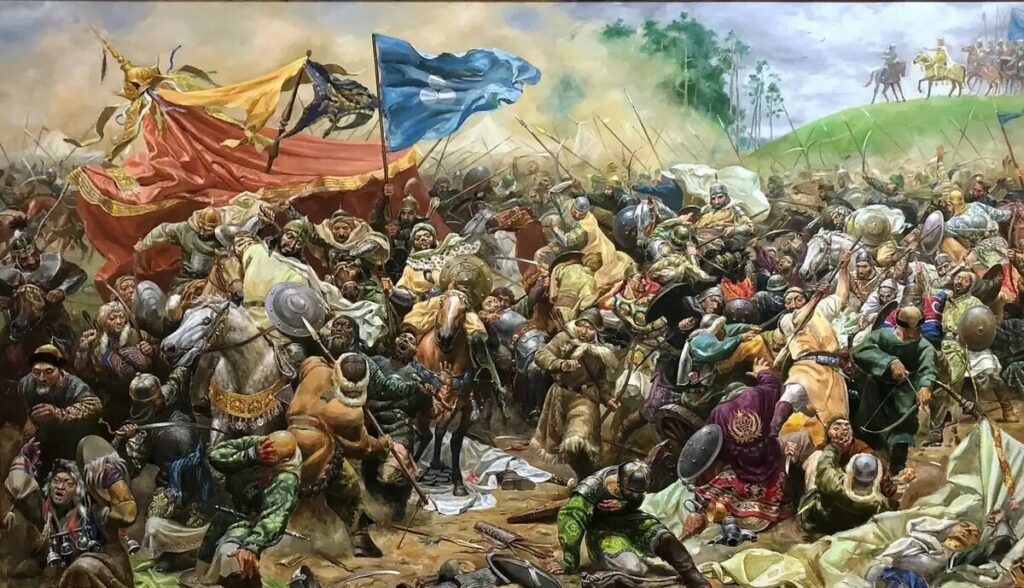In the II century AD, the first Turks appeared in the steppes of the North Caucasus, soon created their first states here — the Kingdom of the Huns -Savir and Jidan, in the VII century the North Caucasus completely came under the control of the Khazar Khaganate, in the depths of which the largest Turkic people of the North Caucasus, the Kumyks, were formed.

Kumyk warriors.
The Kumyk people began to form in the VII century in the North Caucasian steppes, then subordinated to the Khazar Khaganate, but despite everything, the influence of the Khazars on the Kumyk ethnic group turned out to be minimal: in the IX-X centuries, the lands of the Khazar Khaganate began the offensive of the Caspian Sea, fleeing from which the Khazars fled to the mountains of the North Caucasus, leaving their steppe compatriots to their fate. The decisive role in the formation of the Kumyk people was played by the Kipchaks, with whom modern Kumyks are associated much more than even modern Tatars, who are considered direct descendants of the Kipchaks, even they received their self-name from the Kipchaks, who were also called Cumans.

Map of the Khazar Khaganate.

The Kipchak warrior.
Against the background of the death of the Khazar khaganate, the Kumyks managed to gain a foothold in the steppes of Dagestan (actually, the word «Dagestan» is a translation of the Kumyk name «Tavyak» into Persian), where they created their own state, which went down in history under the name of Shamkhalstvo, but the Kumyks themselves did not rule in it for long, during the Western campaign of the Mongols 1236-1242 Shamkhalstvo was conquered, and the conquerors erected a ruler from the Genghisid dynasty to the «liberated» throne, but the real tragedy for the Kumyks was the invasion of Tamerlane in 1395, when the Salatavian Kumyks were completely destroyed, and the rest of Kumykia was devastated.

The Battle of the Terek River on April 15, 1395.

The Caucasus at the beginning of the XV century (yellow — Tarkovsky shamkhalstvo).
Despite the brutality, Tamerlane failed to escape to Kumykia, as soon as his thugs left, the Kumyks began to consolidate in the north of Dagestan, where their new state, named Tarkovsky shamkhalstvo, arose. In the second half of the XV century, the Tarkovsky shamkhalstvo recognized the supreme authority of the Ottoman Empire over itself and in this form began to pose a danger to Russia, which had established itself in the Volga region in the second half of the XVI century. The Russians decided to act preemptively, but a number of military campaigns against Kumykia in the XVI — early XVII centuries ended in failure, nevertheless, the Turks failed to develop an offensive against Russia in the Caucasian direction, because here an insurmountable obstacle stood in their way — the Terek Cossacks.

The Battle of Karaman in 1605.

The Tersk Cossack of the XVII century.
In the middle of the XVII century, the collapse of Tarkovsky shamkhalstvo began, and later Kumykia turned into a real battlefield between Russia, Persia and the North Caucasian highlanders, and the Kumyks themselves at that time fought for the first, then for the second, then for the third, or even for all of the above at once. This bloody madhouse ended only in the second half of the XIX century due to the almost complete destruction of the Kumyks, however, he managed to recover, but the Kumyks became an ethnic minority on their ancestral lands, and currently there is a migration of Kumyks to more prosperous regions of the country (in particular, to the Khanty-Mansi Autonomous Okrug, where the third largest Kumyk diaspora lives there).
